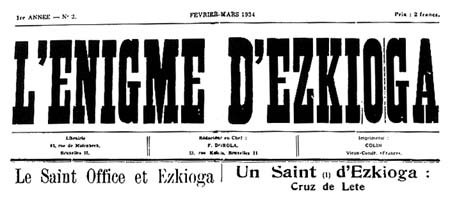Fernand Remisch and L'Enigme d'Ezkioga
Bishop Múgica's fears of foreign interest in the visions were justified. In late 1933 the Belgian Fernand Remisch, a young man drawn to apparitions and mystical events, published a new periodical exclusively about Ezkioga. Remisch was born about 1903 in Arlon, Belgium, the son of a white-collar railway worker and a devoutly Catholic mother. He worked for the steel firm Aciéries de Longwy, first in Longwy, then in Brussels, then in Lyon. It was on a trip with his superiors in the firm that he became interested in Lourdes. He thereafter stopped there whenever in the vicinity, and once he cured his legs of near-paralysis in the holy baths. Lourdes was the impulse for a lifelong spiritual quest that took him all over Europe. Remisch visited the German mystic Thérèse Neumann in 1927, wrote about her, and remained devoted to her until her death. He also became deeply interested in the Belgian visions and wrote for Annales de Beauraing et Banneux . In 1933 he published a short book on Beauraing in which he criticized the gathering of evidence and compared the visions to those of Neumann. Because

Front page, second issue of L'Enigme d'Ezkioga, February 1934 (detail)
he did not want to compromise his business career, he signed his writings with a pseudonym, F. Dorola.[87]
Biographical facts from Remisch's widow in Dijon, 17 December 1983. Remisch, Mystères de Beauraing, 23, 139. He went to Konnersreuth with Ennemond Boniface on 8 July 1931 and 31 August 1932, and in 1933 published his translation of Helmut Fahsel, Thérèse Neumann, la mystique de Konnersreuth (Lessines: Spes). He went back in September 1934 and August 1952. The year before his death he published another book about Neumann, Trentetrois ans. Boniface's first book about her, La Crucifiée, appeared under the name Paul Romain.
Raymond de Rigné was in touch with Remisch and his companion Ennemond Boniface in July of 1933 and no doubt encouraged them to visit Ezkioga. Remisch first went on August 13 and again the same month with Boniface. He wrote favorable articles for a Luxembourg newspaper and the Annales de Beauraing . But once Múgica had condemned the Ezkioga visions, it was not politic to write about them in a journal promoting the Belgian ones. Remisch chose to issue a separate journal in newspaper format, L'Enigme d'Ezkioga .[88]
Boniface dedicated a copy of his book to Rigné in Lyon on 29 July 1933. Article in L'Avenir de Luxembourg, 17-18 September 1933, mentioned in Remisch, "Comment rébondit l'affaire d'Ezkioga," EE 1 (December 1933): 1-2. Not until 1936 did Remisch explicitly denounce Degrelle (EE 11-12 [November 1936]: 6).
The journal appeared at quarterly intervals from December 1933 until the start of the Spanish Civil War, eleven issues in all. Remisch printed Múgica's circular, a summary of the visions, and articles by the abbé Daniel Goens, the theologian Gustave Thibon, and several French doctors. There was also news, not always accurate, of events in Spain and the diocese of Vitoria, reviews of articles and books on Ezkioga, and notices of similar events elsewhere, including stigmatics and "bleeding" crucifixes.[89]
The issues were as follows: 1 (December 1933), 23 rue Ketels, Bruxelles, 46 × 30 cm, 6 pages; 2 (February-March 1934), 8 pages; 3 (May 1934), 37 rue Juliette Récamier, Lyon, 8 pages; 4 (September-October, 1934), 48 × 32 cm, 6 pages; 5 (January 1935), 6 pages; 6 (April-May 1935), 6 pages; 7 (July-August 1935), 6 pages; 8 (October-November 1935), 6 pages; 9 (January-February 1936), 6 pages; 10 (April-May 1936), 6 pages; 11-12 (November-December 1936), 8 pages. The Hemeroteca Municipal of Madrid has a microfilm of the set given to me by Remisch's widow.
Remisch's tactic was to argue for scientific study. His widow told me he had church permission to read books on the Index. The journal did not have the imprimatur. Judging from letters to the editor, its readers were in Belgium, Holland, Luxembourg, and the northeast of France. Spanish readers included Burguera, Luis Irurzun, and even the parish priest of Ezkioga, evidently keeping an eye on the opposition. Rigné at first advertised his photographs in it, but later broke off contact. The journal included photographs and articles about seers Burguera had rejected, so he too declined to collaborate.[90]
Balda to Remisch/Dorola, 7 October 1935, AC 252; Irurzun to Remisch/Dorola, 13 October 1935; ARB 251. For Rigné, EE 1 (December 1933): 5-6; EE 2 (February-March 1934): 5; EE 3 (May 1934): 6; EE 6 (April-May 1935): 2-3; Rigné, "Les Idées"; Rigné, Ciel ouvert, p. B n. 2. For Burguera, B 20, 411, 421-424.